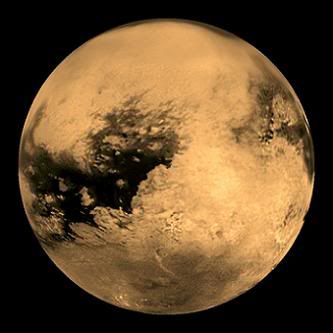Post by glactus on Dec 31, 2010 3:26:06 GMT

Titan
In sci-fi movies, the first stirrings of life happen in a gooey pool of primordial ooze. But new research suggests the action started instead in the stormy skies above. The idea sprang from research led by University of Arizona's Sarah Horst. Her team recreated, in the lab, chemical reactions transpiring above Saturn's largest moon, Titan.
"We're finding that the kind of chemistry an atmosphere can do has intriguing implications for life on Earth and elsewhere in the solar system," says Horst. "Titan's skies might do some interesting chemistry - manufacture the building blocks of life."
Horst and her colleagues mixed up a brew of molecules (carbon monoxide(1), molecular nitrogen and methane) found in Titan's atmosphere. Then they zapped the concoction with radio waves - a proxy for the sun's radiation.
What happened next didn't make the scientists shout "it's alive!" but it was intriguing. A rich array of complex molecules emerged, including amino acids and nucleotides.
"Our experiment is the first proof that you can make the precursors for life up in an atmosphere, without any liquid water(2). This means life's building blocks could form in the air and then rain down from the skies!"
Titan is unique in our solar system. Dotted with lakes and dunes and shrouded in a thick atmosphere of nitrogen and methane, it's a frozen time capsule of early Earth. While the liquid on Titan's surface is methane instead of water, it's the only body in the solar system other than Earth with liquid on its surface.
"We still don't know for sure what the actual molecules are in Titan's atmosphere," says Horst, "but there's a distinct possibility that life's precursors are raining down on the surface of Titan."
Real life may be stranger than science fiction, after all.
Titan
Credits:Dauna Coulter.NASA science.
This is part text only. See full text and all scientists involved at Space Daily.com
www.spacedaily.com/reports/Did_Life_Fall_from_the_Skies_Lessons_from_Titan_999.html


